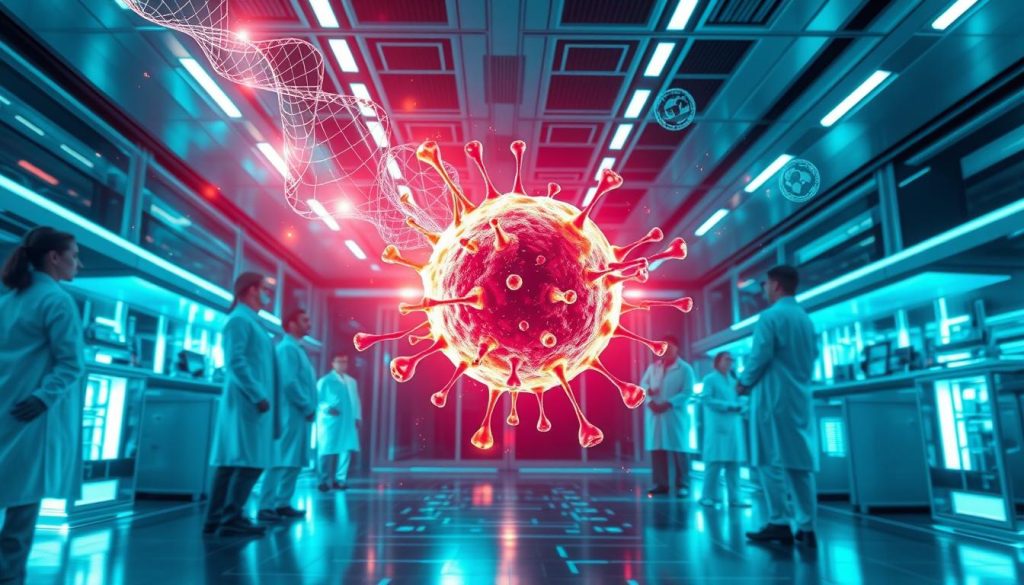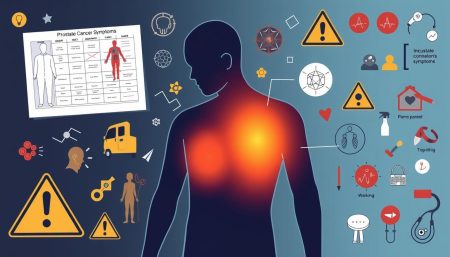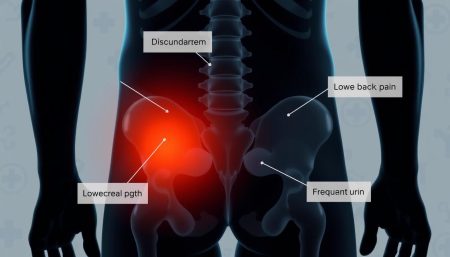CAR T cell therapy is a new way to fight cancer. It uses the body’s immune system to find and kill cancer cells. Kite Pharma is leading this field with treatments for blood cancers.
This therapy is a big step forward in cancer treatment. It makes a patient’s T cells attack cancer cells. It gives hope to those who have tried other treatments.
Kite Pharma is a leader in CAR T cell therapy. They are working hard to help more patients. Their goal is to change cancer treatment and give hope to those with blood cancers.
Understanding CAR T Cell Therapy
CAR T cell therapy is a new way to fight cancer. It uses a patient’s own immune system to attack cancer cells. This method involves changing T cells to target cancer cells only.
By using chimeric antigen receptors and T cells, CAR T cell therapy gives hope to those with hard-to-treat cancers.
What is CAR T Cell Therapy?
CAR T cell therapy is a type of adoptive cell transfer. It takes a patient’s T cells, changes them, and puts them back in the body to fight cancer. The therapy uses a special receptor to find and kill cancer cells.
This way, T cells can find and destroy cancer cells without harming healthy cells.
How CAR T Cell Therapy Works
The therapy involves several steps:
- T cells are taken from the patient’s blood.
- These T cells are then changed in a lab to have a new gene.
- The modified T cells are grown in the lab to make more.
- The patient gets chemotherapy to prepare for the T cells.
- The T cells are put back in the patient to fight cancer.
After being put back in the body, the CAR T cells keep growing. They continue to find and kill cancer cells. This makes CAR T cell therapy different from other cancer treatments.
It offers a chance for long-lasting results in patients with advanced cancers.
Scientists are working hard to make CAR T cell therapy even better. They want to make it work for more cancers and improve how well it works for patients.
Kite Pharma: Pioneering CAR T Cell Therapy
Kite Pharma, a part of Gilead Sciences, leads in CAR T cell therapy for cancer. It aims to change lives of cancer patients. Kite Pharma uses its skills and resources to improve immunotherapy.
Started in 2009, Kite Pharma is a leader in CAR T cell therapy. Its main product, Yescarta (axicabtagene ciloleucel), helps patients with certain lymphomas. It gives hope to those who’ve tried other treatments.
Kite Pharma’s success with Yescarta comes from:
- Advanced research and development
- Work with top universities and scientists
- Focus on patient care and support
The company keeps innovating with its CAR T cell therapies. It’s working on treatments for blood cancers and solid tumors. Kite Pharma’s trials aim to make CAR T cell therapy better and more available.
Kite Pharma’s achievements in CAR T cell therapy:
| Year | Milestone |
|---|---|
| 2012 | Started first CAR T cell therapy trial |
| 2017 | Yescarta (axicabtagene ciloleucel) got FDA approval |
| 2020 | Started trial for KITE-363, a CAR T therapy for solid tumors |
“At Kite Pharma, we aim to bring new, life-changing treatments to patients. Our work in CAR T cell therapy is a big step in fighting cancer.” – Christi Shaw, CEO of Kite Pharma
Kite Pharma keeps exploring new ways in CAR T cell therapy. It’s dedicated to giving life-changing treatments to cancer patients all over the world.
Yescarta: Kite’s Breakthrough CAR T Cell Treatment
Kite, a Gilead Company, has made big strides in CAR T cell therapy with Yescarta. This therapy has shown great results in treating some non-Hodgkin lymphoma types. It gives hope to patients who have tried other treatments without success.
What is Yescarta (Axicabtagene Ciloleucel)?
Yescarta, also known as axicabtagene ciloleucel, is a CAR T cell therapy by Kite. It’s a custom-made treatment that changes a patient’s T cells to fight cancer. The T cells target and kill cancer cells with the CD19 antigen, common in B-cell lymphomas.
Indications and Eligibility for Yescarta Treatment
Yescarta is approved by the FDA for treating certain adult patients with relapsed or refractory large B-cell lymphoma. This includes:
- Diffuse large B-cell lymphoma (DLBCL)
- Primary mediastinal large B-cell lymphoma (PMBCL)
- High-grade B-cell lymphoma
- DLBCL arising from follicular lymphoma
To get Yescarta, patients must have tried at least two other treatments first.
Yescarta Treatment Process
The Yescarta treatment involves several steps:
- T-cell collection: T cells are collected from the patient through leukapheresis.
- Genetic modification: The T cells are changed to target the CD19 antigen on cancer cells.
- Cell expansion: The modified T cells are grown in the lab to make enough for treatment.
- Lymphodepleting chemotherapy: The patient gets a short chemotherapy to prepare for the CAR T cells.
- Yescarta infusion: The modified CAR T cells (Yescarta) are given back to the patient.
- Monitoring and follow-up: The patient is watched for side effects and how well the treatment is working.
| Treatment Step | Description |
|---|---|
| T-cell collection | Leukapheresis |
| Genetic modification | T cells engineered to express CD19-targeting CARs |
| Cell expansion | Modified T cells expanded in the laboratory |
| Lymphodepleting chemotherapy | Short course of chemotherapy to prepare for CAR T cells |
| Yescarta infusion | Genetically modified CAR T cells (Yescarta) infused into the patient |
| Monitoring and follow-up | Close monitoring for side effects and treatment response |
Yescarta is a big step forward in treating certain non-Hodgkin lymphoma types. It offers a chance at life for patients who have tried everything else.
Benefits of CAR T Cell Therapy Kite
CAR T cell therapy, like Kite Pharma’s innovative treatments, has many benefits. It uses the patient’s immune system to fight cancer. This makes it a personalized and effective treatment for some blood cancers.
One big plus of CAR T cell therapy is its precision. It genetically modifies T cells to find and destroy cancer cells. This method is less harsh on healthy cells, reducing side effects from chemotherapy and radiation.
Targeted Cancer Treatment
Its specificity is key. CAR T cell therapy targets cancer cells while sparing healthy tissue. This is a big plus for those with advanced or relapsed blood cancers. It offers a gentler and more effective treatment option.
Potential for Long-term Remission
Another exciting aspect is its chance for long-term remission. Studies show many patients treated with CAR T cell therapy, like Yescarta, have seen complete remission. Some remain cancer-free for years.
“CAR T cell therapy gave me a second chance at life. After years of battling lymphoma, this targeted treatment eliminated my cancer and allowed me to enjoy time with my family again.” – Sarah, CAR T cell therapy recipient
What makes CAR T cells special is their ability to keep fighting cancer long after treatment. This unique feature of CAR T cell therapy Kite offers hope to those who have tried other treatments without success.
Candidates for CAR T Cell Therapy
CAR T cell therapy, including Kite’s groundbreaking treatments, offers hope for patients with certain types of blood cancer. This innovative approach is very effective for those with aggressive non-Hodgkin lymphoma and other blood cancers.
Patients who may be eligible for CAR T cell therapy include those with:
- Diffuse large B-cell lymphoma (DLBCL)
- Primary mediastinal B-cell lymphoma
- High-grade B-cell lymphoma
- Transformed follicular lymphoma
- Mantle cell lymphoma
To be eligible for CAR T cell therapy, several factors are considered:
| Factor | Description |
|---|---|
| Age | Adults, typically 18 years or older |
| Disease status | Relapsed or refractory disease after prior treatments |
| Overall health | Adequate organ function and performance status |
| T cell quality | Sufficient healthy T cells for collection and modification |
“CAR T cell therapy has revolutionized the treatment landscape for patients with advanced blood cancers, providing a personalized and targeted approach to care.”
It’s important to talk to a healthcare professional specializing in CAR T cell therapy, like those at Kite. They can check if this treatment is right for you. Doctors will look at your medical history and cancer type to decide.
The Science Behind CAR T Cell Therapy
CAR T cell therapy is a new way to fight cancer. It uses the body’s immune system to attack cancer cells. This method involves T-cell engineering and chimeric antigen receptors (CARs).
T-Cell Engineering
The first step is to take T cells from the patient’s blood. These T cells are then changed in a lab to have CARs on their surface. This change lets the T cells find and attack cancer cells.
The T-cell engineering process includes several steps:
- Isolation of T cells from the patient’s blood
- Genetic modification of T cells using viral vectors or non-viral methods
- Expansion of the modified T cells in the laboratory
- Quality control and testing of the engineered T cells
- Infusion of the CAR T cells back into the patient
Chimeric Antigen Receptors (CARs)
Chimeric antigen receptors are made from parts of antibodies and T cells. They have three main parts:
- An extracellular domain that recognizes and binds to specific antigens on cancer cells
- A transmembrane domain that anchors the CAR to the T cell surface
- Intracellular signaling domains that activate the T cell upon antigen binding
Over time, CARs have gotten better. The second-generation CARs are the most used in clinics. They have CD3ζ and co-stimulatory domains like CD28 or 4-1BB.
| Generation | Signaling Domains | Characteristics |
|---|---|---|
| First | CD3ζ | Limited efficacy and persistence |
| Second | CD3ζ + CD28 or 4-1BB | Improved activation and persistence |
| Third | CD3ζ + multiple co-stimulatory domains | Enhanced activation, proliferation, and persistence |
CAR T cell therapy combines T-cell engineering and CARs. It redirects T cells to target cancer cells. This makes it a personalized and potentially life-saving treatment for some cancers.
Comparison with Traditional Cancer Treatments
Patients and their families often look into different ways to fight cancer. Car t cell therapy kite is a new option that stands out. It’s different from traditional treatments like chemotherapy and radiation therapy.
Chemotherapy and radiation therapy work by targeting cells that grow fast. This includes both cancer cells and healthy cells. This can cause side effects like tiredness, nausea, hair loss, and a weak immune system. On the other hand, car t cell therapy kite uses the body’s immune system to fight cancer. It’s a treatment that’s made just for the patient.
Car t cell therapy kite starts by taking the patient’s T cells. These cells are then changed to find and attack cancer cells. After that, they are put back into the patient’s body. This method is more precise, which means it can harm fewer healthy cells. This leads to fewer side effects compared to traditional treatments.
| Treatment | Mechanism of Action | Side Effects |
|---|---|---|
| Chemotherapy | Kills rapidly dividing cells | Fatigue, nausea, hair loss, weakened immune function |
| Radiation Therapy | Damages DNA of cancer cells | Skin irritation, fatigue, organ damage |
| CAR T Cell Therapy Kite | Engineered T cells target cancer cells | Cytokine release syndrome, neurological toxicities |
Car t cell therapy kite is a more focused treatment, but it has its own risks. Patients might face side effects like cytokine release syndrome and neurological problems. But, the chance for long-term recovery and better quality of life makes it a hopeful option for many.
CAR T cell therapy represents a significant advancement in the fight against cancer, providing a personalized and targeted approach that distinguishes it from traditional treatments.
As research keeps going, the hope is that car t cell therapy kite will be available to more people. This could bring new hope to those fighting advanced or relapsed cancers.
Potential Side Effects and Risks
CAR T cell therapy has shown great success in fighting cancer. But, it’s important for patients to know about possible side effects and risks. Understanding and managing these side effects is key to the best results.
Cytokine Release Syndrome (CRS)
CRS is a common side effect of CAR T cell therapy. It happens when the immune system gets too active, releasing cytokines quickly. Symptoms can range from mild fever to serious problems like low blood pressure and organ issues.
Neurological Toxicities
Patients may also face neurological side effects. These can include confusion, tremors, seizures, or changes in mental status. The exact cause is not fully known, but it’s linked to the immune system’s reaction to the T cells.

Management of Side Effects
Patients getting CAR T cell therapy are closely watched by their doctors. The severity of CRS and neurological side effects can vary. Quick action is key to managing these issues effectively.
Here are some ways to handle side effects:
- Supportive care, like fever reduction and fluid management
- Medications to control inflammation and suppress the immune response
- Intensive care for severe cases
The table below shows how to manage CRS and neurological side effects:
| Side Effect | Management Strategies |
|---|---|
| Cytokine Release Syndrome (CRS) |
|
| Neurological Toxicities |
|
Knowing about the side effects and risks of CAR T cell therapy helps patients make informed choices. Working with their medical team is essential for the best outcomes. As research improves, managing these side effects will get better, making CAR T cell therapy a more hopeful option for cancer patients.
Success Stories: Patient Testimonials
The impact of CAR T cell therapy Kite on cancer patients is truly remarkable. Many patient stories show how this treatment can change lives. It gives hope to those fighting advanced blood cancers.
Rich Gingerelli, a retired firefighter, was diagnosed with Waldenstrom macroglobulinemia in 1998. Later, he got diffuse large B-cell lymphoma in 2015. After trying many treatments, Rich got CAR T cell therapy and stayed in remission for two years. The Gingerellis were unsure at first but thank their care team at NewYork-Presbyterian/Columbia for their support. This allowed them to enjoy life and plan for the future.
Many cancer survivors have found new hope with CAR T cell therapy Kite:
- Sarah, a young mother with acute lymphoblastic leukemia, got complete remission after CAR T cell therapy.
- Michael, a retired teacher with non-Hodgkin lymphoma, saw a big improvement in his life after treatment.
- Linda, a grandmother with chronic lymphocytic leukemia, celebrated her granddaughter’s wedding just months after CAR T cell therapy.
“CAR T cell therapy gave me a second chance at life. I’m grateful for the incredible advancements in cancer treatment and the dedicated healthcare professionals who made it possible.” – John, a CAR T cell therapy Kite recipient
These stories remind us of CAR T cell therapy Kite’s power to transform lives. They offer hope and inspiration to those facing advanced blood cancers.
Current Research and Future Developments
The field of CAR T cell therapy is growing fast. Scientists and doctors are working hard to make it better. They aim to help more patients with cancer.
Ongoing Clinical Trials
Many clinical trials are testing CAR T cell therapy for different cancers. These trials help us learn more about how it works. They also help make the treatment safer and more effective for more people.
- Phase 1/2 trials are looking at CAR T cells for new targets, like BCMA for multiple myeloma and GD2 for neuroblastoma.
- Studies are also exploring combining CAR T cell therapy with other treatments to improve results.
- Trials are looking into using allogeneic CAR T cells, which can be made in advance and used by many patients.

Expanding CAR T Cell Therapy to Other Cancers
Researchers are also looking into using CAR T cell therapy for solid tumors and other cancers. They face challenges like the tumor environment and finding the right targets. But they are making progress.
- They are working on CAR T cells that can target solid tumors, like HER2 for breast cancer and EGFR for lung cancer.
- They are trying to make CAR T cells better at getting into and staying in solid tumors.
- They are also combining CAR T cell therapy with other treatments to boost its effects.
As we learn more about cancer and the immune system, CAR T cell therapy is getting more promising. With each new trial and discovery, we get closer to helping more cancer patients. This could lead to better treatments and a chance for long-term recovery.
Accessibility and Cost of CAR T Cell Therapy
One big worry about car t cell therapy kite is how easy it is to get and its price. This treatment is very personal and advanced. It’s often very expensive, which stops many patients from getting it.
The cancer treatment cost for CAR T cell therapy changes based on a few things. These include the treatment product, the patient’s situation, and where they get treated. On average, it costs between $375,000 and $475,000 per treatment. This doesn’t include other costs like hospital stays and follow-up visits.
To make things easier for patients, more insurance coverage plans now cover CAR T cell therapy. But, how much they cover can differ. Patients should talk to their healthcare team and insurance to know what they’ll have to pay.
There are efforts to make CAR T cell therapy more available. These include:
- Working together between drug makers and treatment centers to make it more available
- Programs from drug makers to help with costs
- Research to make it cheaper to make
The table below shows the estimated costs for CAR T cell therapy:
| Cost Component | Estimated Range |
|---|---|
| CAR T Cell Product | $350,000 – $450,000 |
| Hospital Stay | $25,000 – $50,000 |
| Supportive Care | $10,000 – $30,000 |
| Follow-up Visits | $5,000 – $15,000 |
“While the cost of CAR T cell therapy can be substantial, it is important to consider the long-term benefits and the chance for lasting remission from cancer.”
As research goes on and making the treatment gets better, its cost is expected to go down. This will make it easier for more patients to get this life-saving treatment.
Collaborations and Partnerships in CAR T Cell Research
The development of CAR T cell therapy is a team effort.  has teamed up with universities, research centers, and pharmaceutical companies. This partnership aims to speed up this groundbreaking therapy’s progress.
has teamed up with universities, research centers, and pharmaceutical companies. This partnership aims to speed up this groundbreaking therapy’s progress.
Kite and the National Cancer Institute (NCI) have a key partnership. They’re working on new CAR T cell therapies for solid tumors. Solid tumors are harder to treat than blood cancers. This partnership combines Kite’s CAR T cell therapy skills with NCI’s research power. They want to make CAR T cell therapy work for more types of cancer.
“Collaborations between industry and academia are essential to advancing the field of CAR T cell therapy. By working together, we can leverage our collective knowledge and resources to develop more effective treatments for patients with cancer.” – Dr. Steven Rosenberg, Chief of Surgery at NCI
Kite has also teamed up with pharmaceutical partnerships to improve its CAR T cell therapies. These partnerships aim to make production smoother, increase output, and get these treatments to patients faster.
| Partner | Type of Collaboration | Focus Area |
|---|---|---|
| National Cancer Institute (NCI) | Research Partnership | Solid Tumor CAR T Cell Therapies |
| Daiichi Sankyo | Pharmaceutical Partnership | Manufacturing and Distribution |
| Sangamo Therapeutics | Research Collaboration | Next-Generation CAR T Cell Technologies |
As cancer research collaborations keep pushing CAR T cell therapy forward, patients will see better and more available treatments. The teamwork in the scientific world is key. It’s what will unlock CAR T cell therapy’s full power and bring hope to cancer fighters.
CAR T Cell Therapy vs. Other Immunotherapies
Immunotherapy is a key area in cancer treatment. CAR T cell therapy is a standout. It’s important to compare it with other immunotherapies to see how they work and their benefits.
Checkpoint Inhibitors
Checkpoint inhibitors block proteins that stop immune cells from fighting cancer. Drugs like Opdivo and Keytruda have helped treat many cancers. This includes melanoma, lung cancer, and kidney cancer.
Checkpoint inhibitors boost the body’s immune fight. CAR T cell therapy, on the other hand, modifies T cells to target cancer cells directly.
Adoptive Cell Transfer (ACT)
Adoptive cell transfer (ACT) uses a patient’s immune cells to fight cancer. It includes TIL therapy and TCR therapy. ACT has shown promise in treating advanced melanoma and some blood cancers.
“ACT has shown promising results in treating advanced melanoma and certain types of blood cancers, but it can be a complex and time-consuming process compared to CAR T cell therapy.”
The table below compares CAR T cell therapy, checkpoint inhibitors, and adoptive cell transfer:
| Immunotherapy | Mechanism of Action | Target Cancers |
|---|---|---|
| CAR T Cell Therapy | Genetically modified T cells target specific cancer antigens | Blood cancers (leukemia, lymphoma), possible for solid tumors |
| Checkpoint Inhibitors | Block proteins that inhibit immune response against cancer | Melanoma, lung cancer, kidney cancer, and others |
| Adoptive Cell Transfer | Collect and use patient’s own immune cells to treat cancer | Advanced melanoma, certain blood cancers |
Each immunotherapy has its own strengths and challenges. CAR T cell therapy is a game-changer for blood cancers. It offers hope for more cancer types as research grows.
Long-term Outlook for CAR T Cell Therapy Patients
Patients who have had CAR T cell therapy have a good outlook. Many stay cancer-free for years after treatment. This therapy offers hope to those with cancers that don’t respond to other treatments.
Surviving cancer is a big part of the journey with CAR T cell therapy. Those who get better need ongoing care. This care includes:
- Regular check-ups with the oncologist
- Monitoring for any signs of cancer recurrence
- Screening for any long-term side effects
- Psychological support and counseling
- Lifestyle recommendations to promote overall health
A study in the New England Journal of Medicine showed promising results. It found that 51% of patients with relapsed or refractory large B-cell lymphoma got better. The study’s results suggest CAR T cell therapy can lead to long-lasting remissions for many patients.
“CAR T cell therapy has given me a second chance at life. I’ve been in remission for over two years now, and I’m grateful for every day I have with my family and friends.” – Sarah, CAR T cell therapy survivor
The table below shows the long-term results of CAR T cell therapy in different studies:
| Study | Cancer Type | CAR T Cell Product | Complete Remission Rate | Median Duration of Response |
|---|---|---|---|---|
| ZUMA-1 (Neelapu et al., 2017) | Large B-cell Lymphoma | Yescarta | 51% | Not reached |
| JULIET (Schuster et al., 2019) | Diffuse Large B-cell Lymphoma | Kymriah | 40% | Not reached |
| ELIANA (Maude et al., 2018) | B-cell Acute Lymphoblastic Leukemia | Kymriah | 81% | Not reached |
As research in CAR T cell therapy keeps improving, so will the long-term results. This means more patients with advanced cancers might get and keep remissions. The work done by Kite Pharma and others is very promising for the future of cancer treatment.
Revolutionizing Cancer Treatment with CAR T Cell Therapy
CAR T cell therapy is changing how we treat cancer, giving hope to those with aggressive blood cancers. It uses a patient’s immune system to fight cancer, a big step in precision medicine. Kite Pharma leads this change, creating therapies like Yescarta for non-Hodgkin lymphoma.
Success stories show CAR T cell therapy’s power. Many who tried other treatments saw big improvements after this therapy. These stories highlight the therapy’s impact on patients and their families.
Research keeps moving forward, promising more for CAR T cell therapy. Trials are looking at using it for other cancers, aiming to help more people. Kite Pharma is working hard, teaming up with experts to make this therapy even better.
CAR T cell therapy is special because it targets cancer in a personal way. It lets a patient’s immune system attack cancer cells. This approach is changing cancer treatment, giving hope to many. With Kite Pharma leading, we’re getting closer to beating cancer for more people.
FAQ
Q: What is CAR T cell therapy?
A: CAR T cell therapy is a new way to fight cancer. It changes a patient’s T cells to attack cancer. These changed T cells are then given back to the patient to fight the cancer.
Q: How does Kite Pharma’s CAR T cell therapy work?
A: Kite Pharma’s therapy starts by taking a patient’s T cells. Then, they make these T cells find and kill cancer cells. The T cells are grown in a lab and given back to the patient.
Q: What is Yescarta (axicabtagene ciloleucel)?
A: Yescarta is a treatment for some lymphomas. It uses the patient’s T cells to fight cancer. It’s a one-time treatment that has shown great results in trials.
Q: Who is a candidate for CAR T cell therapy?
A: This therapy is for people with certain blood cancers. It’s for those who haven’t gotten better with other treatments. Doctors decide if it’s right for each patient.
Q: What are the possible side effects of CAR T cell therapy?
A: Side effects include cytokine release syndrome (CRS) and neurological issues. CRS can cause fever and low blood pressure. Neurological problems might lead to confusion or seizures. Doctors watch for these closely.
Q: How does CAR T cell therapy compare to traditional cancer treatments?
A: CAR T cell therapy is more targeted than chemotherapy or radiation. It aims to kill cancer cells without harming healthy ones. It also might offer long-term remission, giving hope to those with advanced cancers.
Q: What is the long-term outlook for patients who receive CAR T cell therapy?
A: The outlook is good for many patients. They often see long-term remission and better quality of life. But, they need ongoing care to watch for any lasting side effects.
Q: How is Kite Pharma advancing the field of CAR T cell therapy?
A: Kite Pharma leads in CAR T cell therapy research. They work with universities and research centers to improve this treatment. They aim to use it for more cancers and make it more accessible.


















